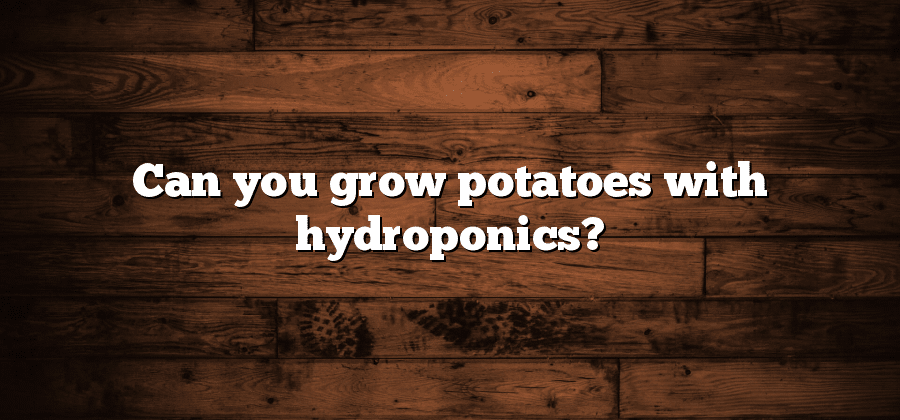Benefits of Growing Potatoes Hydroponically
Potatoes are a versatile and widely consumed staple crop, and growing them hydroponically offers numerous benefits. One of the major advantages is increased productivity. Hydroponic systems provide the ideal environment for potato plants to thrive, resulting in higher yields compared to traditional soil-based cultivation. By eliminating the limitations of soil conditions, hydroponics allows for optimal nutrient uptake and water absorption, leading to faster growth and larger tubers.
Another benefit of hydroponic potato cultivation is water efficiency. Traditional farming methods often require excessive amounts of water to maintain soil moisture, leading to water wastage and environmental concerns. In hydroponics, water is recycled and reused within the system, significantly reducing water usage. Additionally, the controlled environment of hydroponics minimizes the risk of water runoff and nutrient leaching, ensuring that the plants receive the necessary elements without compromising water resources. This makes hydroponics a more sustainable and eco-friendly option for potato production.
Ideal Conditions for Hydroponic Potato Growth
To ensure optimal growth and a bountiful harvest when growing potatoes hydroponically, it is crucial to provide the ideal conditions for their development. One key factor is maintaining a stable air temperature between 60 and 70 degrees Fahrenheit (15 to 21 degrees Celsius). This range promotes healthy root growth and discourages the formation of tubers prematurely. Additionally, maintaining a relative humidity level around 70 percent is essential to prevent the drying out of the potato plants and ensure proper moisture uptake.
In hydroponic potato cultivation, light plays a fundamental role in their growth and development. Potatoes require a minimum of 12 to 16 hours of light per day for optimal growth. Using high-intensity discharge (HID) lights with a spectrum that mimics natural sunlight can ensure the plants receive the necessary amount of light energy. Positioning the lights at an appropriate distance from the plants is equally important to prevent photoinhibition or light burn. By closely monitoring and adjusting these environmental factors, hydroponic growers can create the ideal conditions for successful potato cultivation.
Selecting the Right Potato Varieties for Hydroponics
When it comes to selecting the right potato varieties for hydroponics, there are a few factors that need to be considered. Firstly, the growth habit of the potato variety is important. Some varieties are naturally bushier and more compact, while others tend to have longer vines. For hydroponic systems, it is generally recommended to choose varieties that have a more compact growth habit, as they can be easier to manage and train within the limited space of the growing system.
Another important factor to consider is the yield potential of the potato variety. Different varieties have varying levels of productivity, and it is essential to select ones that can provide a good harvest within the constraints of the hydroponic system. Look for potato varieties that are known for their high yields or have been specifically bred for hydroponic cultivation.
Additionally, it is crucial to choose potato varieties that are disease-resistant. Hydroponic systems can sometimes create conditions that are conducive to the development and spread of diseases. Opting for varieties that are resistant to common potato diseases like late blight, scab, and viruses can help ensure a successful and healthy harvest.
Lastly, consider the culinary qualities of the potato varieties. Different varieties have different tastes, textures, and uses in the kitchen. Determine whether you prefer a fluffy baking potato, a firm salad potato, or a versatile all-rounder. This will help you select varieties that best suit your preferences and culinary needs.
By considering the growth habit, yield potential, disease resistance, and culinary qualities of different potato varieties, you can make informed decisions when selecting the right ones for hydroponic cultivation. Remember that experimentation and adaptation may be necessary to find the best-suited varieties for your specific hydroponic setup and desired results.
Preparing the Hydroponic System for Potato Cultivation
To prepare the hydroponic system for potato cultivation, it is important to pay attention to several key factors. Firstly, consider the size and type of hydroponic system that will be used. Potatoes require a considerable amount of space to grow, so a system with deep and spacious containers is ideal. Additionally, the system should provide adequate support for the plants as they grow, ensuring that they do not become entangled or overcrowded.
Another crucial aspect of preparing the hydroponic system is selecting the appropriate growing medium. Potatoes thrive best in a well-draining medium that is rich in nutrients. One popular option is a mix of perlite and coconut coir, which provides excellent aeration and moisture retention. It is important to thoroughly wash and sterilize the growing medium before use to prevent the introduction of any harmful pathogens or pests. By carefully considering these factors, the hydroponic system can be effectively prepared for successful potato cultivation.
Starting Potatoes from Seed or Seedlings in Hydroponics
There are two primary methods for starting potatoes in hydroponics: from seeds or from seedlings. Starting from seeds allows for a wider selection of potato varieties but requires more time and patience. It involves germinating the potato seeds in a controlled environment, such as a nursery or a germination chamber, before transferring them to the hydroponic system.
On the other hand, starting from seedlings provides an advantage in terms of time and ease of transplanting. Seedlings are already established plants that have been grown from seeds in a separate environment. This method eliminates the need for germination and allows for quicker growth and development in the hydroponic system.
Regardless of the chosen method, it is essential to ensure that the potato seed or seedlings are healthy and disease-free before starting them in the hydroponics system. This can be achieved by sourcing seeds or seedlings from reputable suppliers and thoroughly inspecting them for any signs of damage or disease. In addition, providing the appropriate conditions, such as appropriate lighting, temperature, and nutrient levels, will greatly enhance the success rate of starting potatoes in hydroponics.






